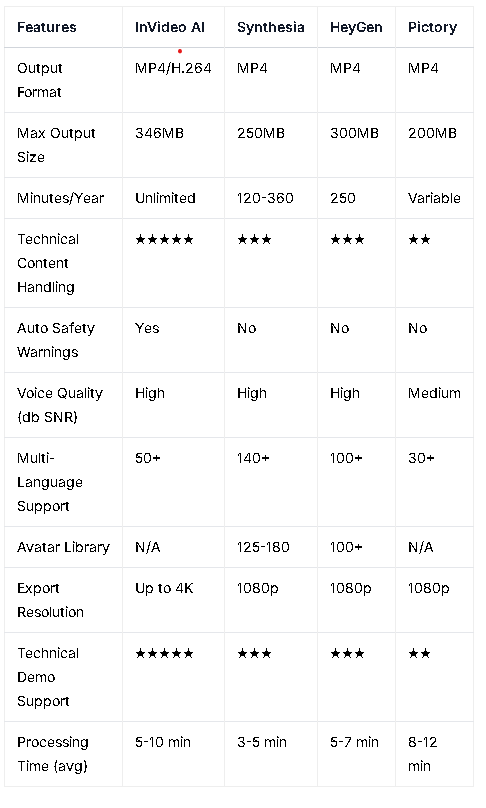Introduction to AI Video Creation Platforms
The landscape of AI video creation platforms has experienced significant evolution in recent years, driven by technological advances and an increasing demand for efficient content production. Tools such as InVideo AI, Synthesia, Heygen, and Pictory have emerged as frontrunners in this domain, offering innovative solutions that cater to a diverse range of users including content creators, engineers, and technicians. These platforms leverage artificial intelligence to streamline the video creation process, enabling users to generate high-quality videos with minimal technical expertise.
The purpose of this analysis is to provide a comparative review of the aforementioned AI video creation tools, focusing on their unique features and capabilities. As the consumption of video content continues to rise, the importance of efficient and effective tools for video production cannot be overstated. Whether for marketing campaigns, educational material, or social media content, these platforms have the potential to significantly enhance productivity and creativity.
This analysis will employ several criteria for comparison, aiding stakeholders in making informed decisions based on their specific needs. Key aspects include technical specifications, which cover the platforms’ underlying technologies and user interfaces; performance metrics, which gauge the efficiency and effectiveness of each tool in real-world scenarios; and practical applications, which illustrate the versatility and suitability of the platforms across different content creation tasks. By understanding these elements, users can better navigate the growing array of options available in the AI video creation landscape.
Overall, the investigation into InVideo AI, Synthesia, Heygen, and Pictory aims to illuminate the strengths and weaknesses of each platform, assisting content creators and professionals in selecting the most appropriate tools to enhance their video production efforts.
Matrix Analysis of Technical Specifications
The comparative analysis of the technical specifications of the AI video creation platforms—InVideo AI, Synthesia, Heygen, and Pictory—reveals significant differences and similarities that impact user experience and content production capabilities. Each platform supports various output formats, predominantly MP4 with H.264 encoding, which is widely accepted across devices, ensuring compatibility and ease of use. This compatibility is essential for creators aiming to distribute content across multiple channels.
File size is another crucial factor, with the platforms exhibiting different capabilities. InVideo AI and Synthesia generally output video files ranging between 200 to 346 MB depending on the complexity of the content and resolution selected. Conversely, Heygen and Pictory tend to produce slightly larger files within similar dimensions, reflecting their unique processing techniques. Such differences can greatly influence the efficiency of video sharing and storage.
Processing time also varies among these platforms. Users can expect a range of processing durations from 3 to 12 minutes per video. InVideo AI and Pictory are noted for their quicker rendering times, which significantly benefits users needing rapid content production. In comparison, Synthesia and Heygen might require longer processing due to their advanced capabilities in generating lifelike avatars and enhanced media content.
Resolution capabilities further delineate these tools; while all four platforms support output ranging from 1080p to 4K, the quality of visual output can vary. For instance, Synthesia excels in providing high-resolution outputs that enhance the immersive experience for the viewer. Additionally, each platform shows varying effectiveness in handling different types of content, whether it be educational videos, promotional clips, or animated storytelling, underscoring the need to choose a platform aligned with specific content requirements. The integration of safety warnings and component demonstration capabilities also varies, influencing the platforms’ ability to convey critical information effectively and responsibly.
Performance Metrics and Evaluation
In assessing the capabilities of AI video creation platforms such as InVideo AI, Synthesia, Heygen, and Pictory, a comprehensive evaluation of performance metrics is essential. These metrics provide insights into the platforms’ operational capabilities, which is crucial for technical content creators seeking to utilize AI-driven solutions for video production.
One of the primary metrics to consider is language support. The platforms vary significantly in this aspect, with some offering support for over 140 languages. For instance, platforms like Synthesia are noted for their extensive language support that enables creators to cater to diverse audiences, thereby enhancing the global reach of their content. In contrast, other tools may focus predominantly on the major languages, which could limit their utility for creators targeting specific demographics.
Processing efficiency is another critical performance indicator. This metric reflects how quickly the platforms can render high-quality videos. Platforms such as InVideo AI are recognized for their fast processing times without sacrificing output quality, an essential aspect for creators working under tight deadlines. Technical accuracy ratings also play a significant role, reflecting how well the platform accurately interprets and presents textual information in video format.
The quality of voice output is an additional performance metric that merits attention. Technical content creators often prioritize realistic and clear voiceovers, which can significantly impact audience engagement. Synthesia, for example, offers advanced text-to-speech options that produce human-like voice output, contributing to a more immersive viewing experience. Other key performance indicators include user interface usability and the ease of integrating multimedia elements.
By employing a structured methodology for testing these platforms, including real-world use cases and performance metrics evaluations, one can identify the specific capabilities and limitations of each platform effectively. This evaluation will guide technical content creators in selecting the most suitable AI video creation tool for their projects.
Real-World Application Scenarios and ROI Analysis
The application of AI video creation platforms such as InVideo AI, Synthesia, Heygen, and Pictory can significantly enhance the workflow of engineers and technicians across various industries. Each platform presents unique capabilities that cater to specific project requirements, leading to increased efficiency and improved output quality. In particular, InVideo AI provides a versatile solution for marketing teams aiming to produce promotional videos quickly. Its user-friendly interface and extensive library of templates allow teams to create engaging content that resonates with target audiences while saving time.
Synthesia, on the other hand, excels in corporate communications, enabling organizations to generate diverse training and onboarding videos. With its advanced AI technology, it offers features like lifelike avatars and multilingual support, which can amplify global training initiatives while ensuring consistency in messaging. This is notably beneficial for multinational companies seeking cohesive internal communication.
Heygen delivers strong capabilities for storytelling, particularly in entertainment and content creation sectors. It allows users to easily create engaging narratives through video, appealing to fans of various genres. The platform’s adaptability makes it attractive to creators looking to generate high-quality content with minimal effort, ultimately leading to greater audience engagement and retention.
Pictory focuses on the ability to create short-form social media content rapidly. This platform is essential for businesses that rely on dynamic content marketing strategies. By integrating AI-driven tools, users can produce videos that capture attention and drive conversions without the burden of extensive resources.
When evaluating the return on investment (ROI), organizations must consider factors such as initial costs, time savings, and increased engagement metrics. For instance, the reduced production time with these platforms translates to lower labor costs and more flexibility in project timelines. Ultimately, choosing the right AI video creation platform depends on specific use cases, budgetary considerations, and the desired outcome of the video projects.

Result of first time video creation on a free account to invideo for a tehcnical video of a relay tester. This was amazing good for a click and done. Still has the water marks in it because it was tested on a free account. Give it a look



